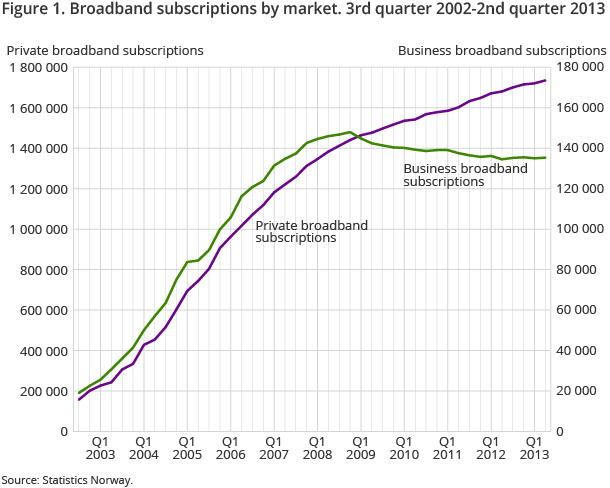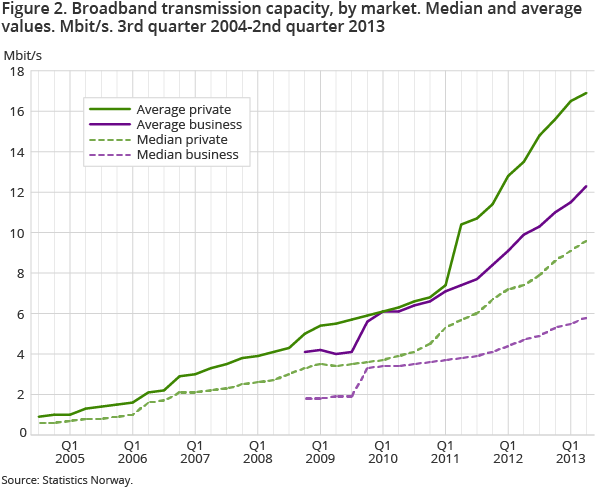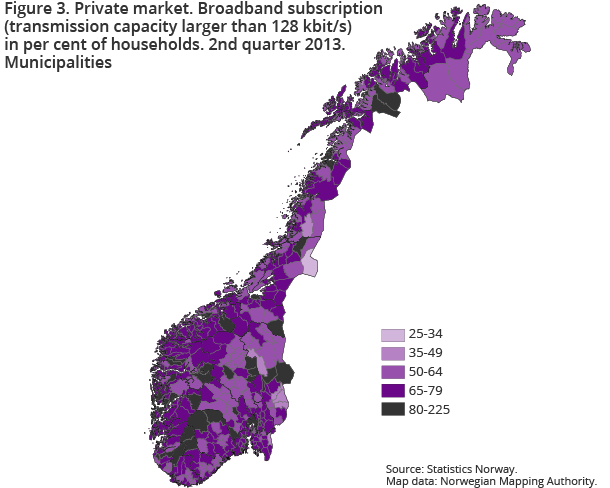Content
Published:
This is an archived release.
Growth in private broadband continues
The number of private fixed broadband connections has increased by 14 000 in the last quarter. The average capacity of private fixed broadband access increased 25 per cent last year. For business broadband, the increase was 24 per cent.
| 2nd quarter 2013 | 1st quarter 2013 | 2nd quarter 2012 | 2nd quarter 2012 - 2nd quarter 2013 | ||
|---|---|---|---|---|---|
| Change | Change i per cent | ||||
| Fixed broadband | 1 871 375 | 1 856 774 | 1 815 985 | 55 390 | 3.1 |
| Private broadband | |||||
| Private broadband subscriptions | 1 735 985 | 1 721 667 | 1 681 360 | 54 625 | 3.2 |
| Private broadband subscriptions per 100 households | 76.8 | 76.2 | 75.1 | 1.7 | 2.3 |
| Average transmission capacity (Mbit/s) | 16.9 | 16.5 | 13.5 | 3.4 | 25.2 |
| Median transmission capacity (Mbit/s) | 9.6 | 9.1 | 7.4 | 2.2 | 29.7 |
| Business broadband | |||||
| Business broadband subscriptions | 135 390 | 135 107 | 134 625 | 765 | 0.6 |
| Average transmission capacity (Mbit/s) | 12.3 | 11.5 | 9.9 | 2.4 | 24.2 |
| Median transmission capacity (Mbit/s) | 5.8 | 5.5 | 4.7 | 1.1 | 23.4 |



The number of private broadband subscriptions with fixed access in Norway, including Svalbard, was 1 736 000 at the end of the 2nd quarter of 2013; an increase of 55 000 subscriptions in the last 12 months. Compared to the previous quarter, this is an increase of 14 000 subscriptions.
The number of business subscriptions is stable at around 135 000.
Steady increase in broadband capacity
The average transmission capacity for fixed private broadband has increased from 16.5 to 16.9 Mbit/s since the previous quarter. At the same time, the median value has increased to 9.6 Mbit/s from 9.1 in the previous quarter. One year ago, the average transmission capacity was 13.5 Mbit/s and the median value was 7.4 Mbit/s.
The average transmission capacity for fixed business broadband has increased to 12.3 from 11.5 Mbit/s in the previous quarter. At the same time, the median value increased to 5.8 Mbit/s compared to 5.5 in the previous quarter.
Private broadband subscriptions with a capacity of more than 8 Mbit/s total 54 per cent; an increase from 53 per cent in the previous quarter. Only 38 per cent of business broadband subscriptions have this capacity; an increase from 36 per cent in the previous quarter.
The broadband penetration rate in private households is 77 per cent, which is an increase from last year’s 75 per cent. The figure for private broadband subscriptions per 100 households varies between 86 per cent in the county of Oslo and 64 per cent in the county of Finnmark.
Not all providers are included Open and readClose
The number of Internet service providers reporting to this survey has been around 200 over the past few years. Market changes have reduced this number to around 170. A few small, but potentially locally important Internet service providers, mostly cable TV providers, may still not be included in the survey. Efforts have been made to include these providers. Some small errors related to the distribution of subscribers between municipalities may occur. This can have major consequences for the figures per household for some municipalities.
The difference between the number of subscribers and the number of householdsOpen and readClose
Individuals and businesses can have several Internet subscriptions and several individuals can use the same subscription. The number of subscriptions is therefore not equivalent to the number of households/businesses with Internet access. A household can for instance get Internet access through an employer, educational institution or by sharing access with other households. The survey ICT usage in households provides more information about households with at least one member under the age of 75 with Internet access.
Contact
-
Statistics Norway's Information Centre
E-mail: informasjon@ssb.no
tel.: (+47) 21 09 46 42
